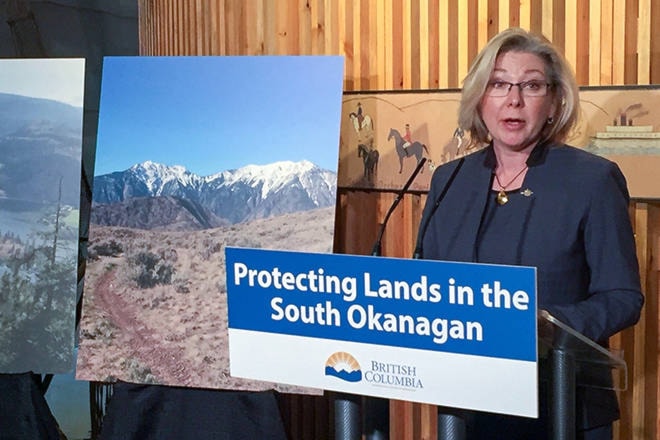It’s no national park, but the province is taking positive steps to protect three environmentally-sensitive areas of the South Okanagan.
Visiting the Nk’mip Desert Cultural Centre, Environment Minister Mary Polak announced Friday (Jan. 27) that planning discussions to achieve the objectives outlined in the province’s proposal to protect lands in the South Okanagan are moving forward.
The proposal received support and participation of the Lower Similkameen Indian Band, Penticton Indian Band and Osoyoos Indian Band, the three Okanagan Nation communities most affected by the proposal.
OIB Chief Clarence Louie said he was asked to represent the three First Nations involved at the press conference.
“We welcome the dialogue, we welcome the negotiating table and the many, many meetings that will occur in the upcoming weeks and months on pieces of land that are very important to so many people in B.C.,” said Louie. “The three First Nations are willing to be at the table, willing to work through this complicated process and see where we wind up in the future.”
Doreen Olson, co-ordinator for the South Okanagan Similkameen National Park Network, said the announcement is a positive move.
“I am really happy that First Nations are now involved. That is a very positive step going forward,” said Olson, adding that another positive step is the involvement at the federal level, with a response from Environment Minister Catherine McKenna, who said she is looking forward to discussion the potential for a park reserve.
“A new national park reserve would provide an opportunity to protect one of Canada’s iconic natural and cultural landscapes and share this unique and inspiring landscape with Canadians and visitors from around the world,” said McKenna.
“It would also bring us a step closer to establishing a system of national parks that represents each of Canada’s 39 distinct natural regions and contribute to reaching Canada’s 17 per cent biodiversity land target by 2020, in collaboration with the provinces, Indigenous groups and other key partners.”
“I am happy she has responded with a very positive statement,” said Olson, adding that everything seems ready to go for discussions. “People just need to get on the airplane.”
Parks Canada was not a party to the development of the province’s protected areas plan for the South Okanagan, nor involved in its public review.
The Protected Areas Framework was first presented in an intentions paper in August 2015, and the results of the public feedback received were released in May 2016.
The Ministry of Environment said it carefully reviewed the feedback received from the public engagement, which drew more than 3,400 submissions.
From there, the ministry engaged directly with the three Okanagan Nation communities regarding the priorities identified in the plan.
Louie said the goals of protecting the lands from encroachment and the species at risk, some that are only found in the region, are important. Existing use policies are also important, he said, including hunting and fishing rights as well as jobs.
The province is proposing a large area, west of Osoyoos and south of Highway 3 to the U.S. border including the Osoyoos Desert Centre, the lands around Spotted Lake and portions of the South Okanagan Grasslands Protected Area sites of East and West Chopaka and South Kilpoola, to be considered by Parks Canada for inclusion in a South Okanagan National Park Reserve.
The same goes for another area covering portions of the White Lake basin area south of Okanagan Falls and including areas in the vicinity of Vaseux Lake.
Portions of the area west of Oliver towards Cawston, and north of Highway 3 to the southerly extent of the White Lake Grasslands Protected Area will be targeted for protection as a conservancy under the Park Act.
Polak said they have reached out to federal government and got a positive response from McKenna.
“She has welcomed the invitation to engage in talks around the three areas,” said Polak, adding the province is sticking to protecting existing uses in the protected areas, which range from ranching to helicopter flight training.
In late December, MLA Linda Larson — who was also at the press conference expressing support for the discussions — told the Regional District of Okanagan-Similkameen that Parks Canada would not discuss continuing existing uses.
“We are coming from the standpoint of existing uses continue. That’s our starting point, that is the commitment we have made to people who do have concerns,” said Polak. “Those are the discussion we will have with the federal government, as to whether they are willing to engage around a national park reserve with those parameters.”
In past discussions about creating a national park, this has been a sticking point, but Polak thinks the federal government has softened its stance.
“My impression was they are far more open to that than they ever were,” said Polak.
Any changes are going to be some time in coming. Polak said there won’t be any policy-level decisions made until after the May 9 provincial election.
*More:* [Feedback on proposed South Okanagan National Park](http://www.pentictonwesternnews.com/news/380727191.html)
*More:* [National park update from MLA Larson](http://www.pentictonwesternnews.com/news/408538645.html)
*Related:* [Study found plenty of local support for national park](http://www.pentictonwesternnews.com/news/151605325.html)
[intentions paper in August 2015](http://www.pentictonwesternnews.com/news/321829661.html)
[Environment Minister Catherine McKenna](https://www.canada.ca/en/government/ministers/catherine-mckenna.html)
[Nk’mip Desert Cultural Centre](http://www.nkmipdesert.com/)
